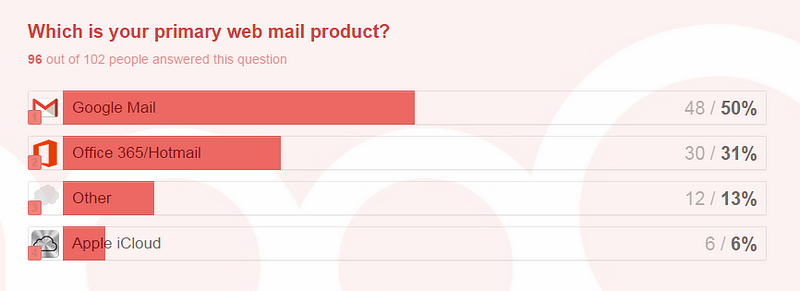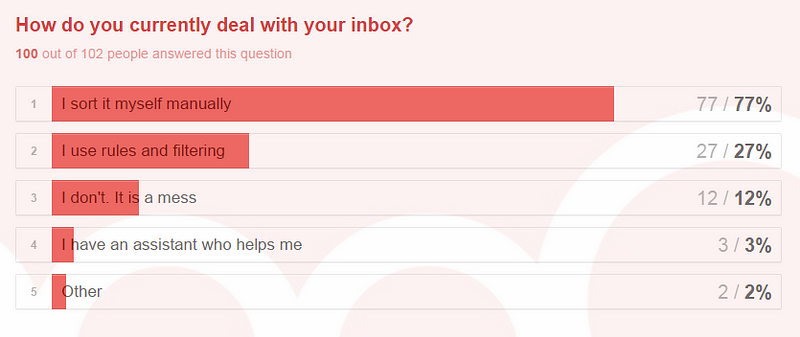Ratings for Web Mail — Google GMail vs Office365 Hotmail
Part 2 of 4 Blog Series
nooQ has huge potential, but we can’t build everything at once.
We’ve had a lot of demand for new features and new products visualizing email, visualizing social data and other overloaded, noisy systems.
So we created a survey on our existing team communication product, plus we wanted some research on what to build next. We needed to examine current usage of email, enterprise social networks, social media and file sharing. We needed to quantify the demand, in order to focus on the right things.
The results were somewhat surprising.
We had 102 completed surveys from participants. We had very carefully selected participants and were delighted with the responses and comments.
e-Mail Overload
As McKinsey pointed out just much of our time is spent — and, I’d argue,wasted — in our inboxes. Consider the Radicati Group’s E-mail Statistics Report, 2013–2017. Among the study’s most interesting findings:
- E-mail remains the go-to form of business communication. In 2013, business e-mail accounts totalled 929 million. The number of mailboxes is expected to grow annually at a rate of 5 percent over the next four years, reaching over 1.1 billion by the end of 2017.
- More than 100 billion business e-mails were sent in 2013 every day. That number is expected to exceed 130 billion by 2017.
- The average employee receives roughly 120 to 150 e-mails per day, a number that’s growing by 15 percent annually. (This means that, at this rate, you’ll receive twice as many messages in about 4.5 years.)

Brass tacks: The numbers are staggering, but the explanation is fairly straightforward. There’s a simple reason that most of us are drowning in our inboxes. As also seen in Message Not Received: Why Business Communication Is Broken and How to Fix It by Phil Simon, we use e-mail for just about everything.
eMail Usage Survey Results





Desktop eMail Application — Outlook vs Apple Mail





eMail Usage Volumes


Findings
We thought there were some surprising findings on email usage, especially volumes with 58 from 102 responses getting less than 50 emails per day. Maybe they all have notifications switched off and unsubscribed from everything, ever.
That wouldn’t have stopped us building a new interface for email.
The truth is out there, Outlook is a more popular product than Apple Mail!
Although personally I think they are both equally terrible, they are perfectly adequate and functional if you have low volumes of email but are painful to use if you are a 200+ emails per day power user.
User choice and distribution sum up the email product category and user decisions on which vendor can only really be described as apathetic.
People choose products that are given to them. Microsoft and Apple have the distribution sown up and people start using them, without looking for alternatives. Google and Gmail aside, which users choose because of the strength of the Google brand, seems to be the most popular choice (or only choice) outside the Apple/Microsoft duopoly.
Unsurprisingly, most people don’t sort and filter their email automatically preferring to keep themselves busy sorting, deleting and ignoring the same emails every day.
We believe there should be a better way of communicating and also managing e-mail using our visual interface with our machine learning algorithms to sort, filter and prioritise everything for you.
The challenge is funding the marketing and distribution for that product. We have the answer, the most innovative solution on the market, people want our product but we don’t have the funding to deliver it. The distribution is tightly controlled by Microsoft, Apple and Google.
Outlook, Apple Mail and Gmail/Inbox are all free products from companies with extreme wealth. It is a challenge to get people to buy a product that big brands offer for free.
Dropbox tried to break that with mailbox and have pulled out of an expensive failure to concentrate on building apps that get people out of the email overload as there is only so much you can do to fix email.
We will keep our ideas on how to fix this for the moment as the other problems uncovered in our survey, we have solutions that are easier to build, & more lucrative.
Fixing e-mail we will come back to once we have more money in the bank.
What do you think?
Do you think our conclusions are correct?
Please comment, email or tweet.
Stay tuned for parts 3 and 4, where we will reveal what we will do next.



